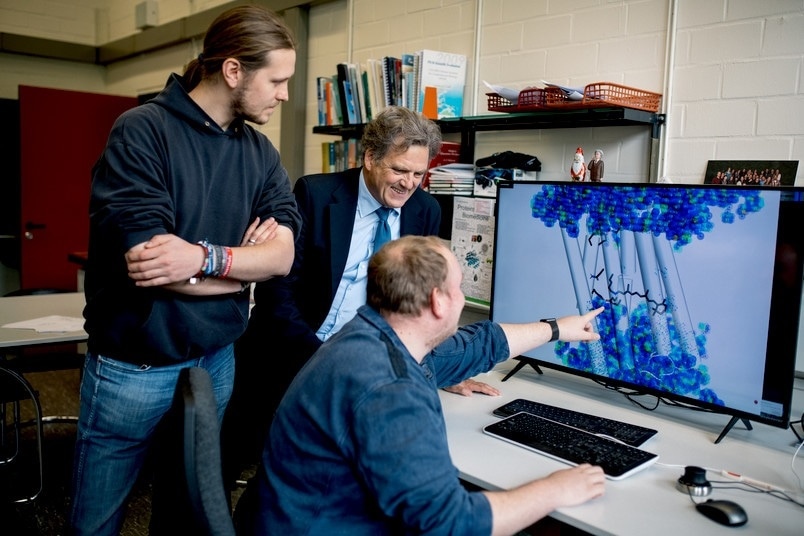Apr 24 2019
Optogenetics uses light to regulate brain processes. It is based on light-regulated proteins such as channelrhodopsin-2, an ion channel that opens when it is uncovered to light, thus triggering cellular processes. In association with colleagues from Humboldt-Universität zu Berlin, the scientists from Ruhr-Universität Bochum (RUB) have currently provided insight on its mode of action. The team guided by Professor Klaus Gerwert and Professor Peter Hegemann has published its findings in the journal PNAS on April 19th.
 Max Dreier, Klaus Gerwert and Stefan Tenningkeit (from the left) look at the representation of a protein. © RUB, Kramer
Max Dreier, Klaus Gerwert and Stefan Tenningkeit (from the left) look at the representation of a protein. © RUB, Kramer
Enormous therapeutic potential
Scientists believe optogenetics have a huge therapeutic prospect. “It is feasible that light might be used to make blind people see or to treat agitated paralysis in Parkinson’s patients,” explains Klaus Gerwert.
Channelrhodopsin-2 is the central light-activated protein, discovered by Peter Hegemann, in optogenetics. If this ion channel is applied to nerve cells, the channels can be opened by light, thus stimulating the cell.
In the past researchers could not decide on how the channel is stimulated. “But it is precisely the understanding of the molecular reactions in the protein and of the ionic conductivity resulting thereof that is essential for optimising the protein for its potential applications,” says Gerwert.
Two parallel paths
With combined forces, the scientists from Bochum and Berlin discovered how the channel is stimulated exhaustively. By integrating time-resolved Fourier Transform Infrared Spectroscopy, electrophysiological experiments, and biomolecular simulations, they showed that photoexcitation activates two different structures—and not, as formerly presumed, just one. One of them results in the requisite channel activation that is used in optogenetics. The parallel path offers just a weak proton stream; but, the longer exposure, the more it gains the upper hand and overpowers the requisite channel activation. Consequently, the optogenetic tool soon begins to lose its efficiency. “If we block the unwanted parallel path by implementing specific protein design, we could optimise the optogenetic tool considerably,” concludes Gerwert.
Performing research into channelrhodopsin, the Bochum-based scientists drew on their widespread experience concerning the mechanism of the light-stimulated proton pump bacteriorhodopsin, which they solved carefully several years ago. “Just as in bacteriorhodopsin, protein-bound water molecules play a crucial role in proton conductivity,” explains Klaus Gerwert.